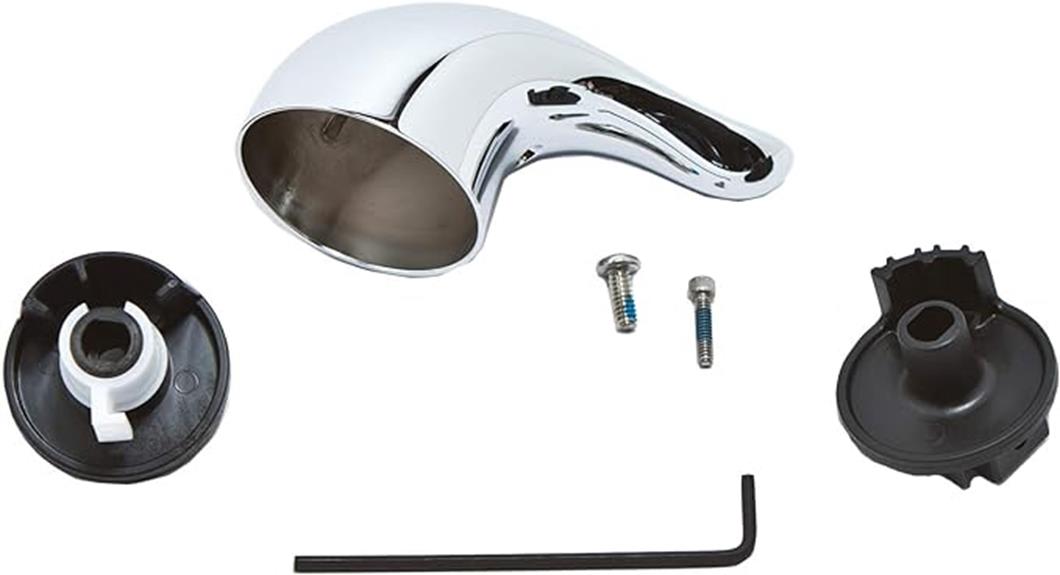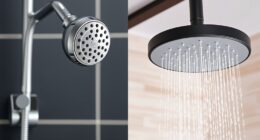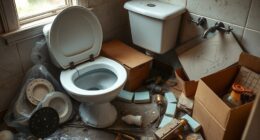Oh, the joys of finding a mysterious ring in the toilet bowl. It’s a sight that never fails to make my day…said no one ever. But alas, here we are, diving into the perplexing world of what causes that unsightly toilet bowl ring.
Fear not, my friends, for in this article, I shall unravel the secrets behind this pesky phenomenon. Join me on this journey as we explore the common culprits, the impact of mineral deposits, and the importance of proper cleaning practices.
Let’s bid farewell to the ring and reclaim our porcelain thrones!
Key Takeaways
- Hard water stains, caused by high mineral content in water, can lead to unsightly marks on the toilet bowl surface.
- Mineral buildup over time creates a thick layer of deposits, causing stains, discoloration, reduced water flow, and unpleasant odor.
- Inadequate cleaning techniques, such as improper scrubbing or using abrasive materials, hinder the removal of stains and rings.
- Preventive measures, such as using a toilet brush with firm bristles, applying suitable cleaning solutions, and using toilet bowl cleaners specifically designed to remove stains and prevent mineral deposits, can help avoid toilet bowl rings.
Significance of Toilet Bowl Ring
The significance of a toilet bowl ring is that it indicates a buildup of minerals and bacteria. As someone who is responsible for toilet bowl maintenance, it is crucial to understand the importance of removing stubborn stains.
These stains not only make the toilet bowl look dirty and unappealing, but they also harbor harmful bacteria that can pose health risks. By regularly cleaning and preventing the buildup of minerals, you can maintain a hygienic and visually pleasing toilet bowl.
There are various methods and products available for removing stubborn stains, such as using a toilet brush with a cleaning solution or utilizing a pumice stone to gently scrub away the ring. Remember to always follow the manufacturer’s instructions and take necessary safety precautions when performing toilet bowl maintenance.
Common Culprits for Toilet Bowl Ring
When it comes to the common culprits for toilet bowl rings, there are a few key points to consider.
First, hard water stains can leave unsightly marks on the surface of the toilet bowl due to the high mineral content in the water.
Second, mineral buildup can occur over time, leading to a thick layer of deposits that can be difficult to remove.
Lastly, inadequate cleaning techniques can contribute to the formation and persistence of toilet bowl rings, as improper cleaning methods may not effectively remove the stains and buildup.
Hard Water Stains
Calcium and magnesium in hard water can create stubborn stains in toilet bowls. These mineral deposits, commonly referred to as hard water stains, can be quite challenging to remove.
Hard water damage occurs when the minerals in the water react with surfaces, leaving behind unsightly stains. To tackle these stains, there are several effective methods for removing hard water stains from toilet bowls.
One option is to use a mixture of vinegar and baking soda. Simply pour the vinegar into the toilet bowl, followed by a sprinkling of baking soda. Allow the mixture to sit for a few minutes before scrubbing the stains away with a toilet brush.
Another option is to use a commercial descaler specifically designed to remove hard water stains. These products often contain acidic ingredients that dissolve the mineral deposits, making them easier to clean.
Mineral Buildup
Mineral buildup in the toilet can be effectively removed with a mixture of vinegar and baking soda. The inorganic residue left behind by mineral accumulation can be stubborn and difficult to remove. However, by using this simple and natural solution, you can easily get rid of the unsightly stains.
To further understand the impact of mineral buildup, let’s take a look at the table below:
| Effects of Mineral Buildup | Emotion |
|---|---|
| Stains and discoloration | Frustration |
| Reduced water flow | Annoyance |
| Unpleasant odor | Disgust |
| Difficult to clean | Irritation |
As you can see, the inorganic residue left by mineral accumulation can have a negative impact on our emotions. That’s why it’s important to address this issue promptly. By using the vinegar and baking soda mixture, you can effectively remove the mineral buildup and restore the cleanliness and functionality of your toilet.
Inadequate Cleaning Techniques
If you’re not using the right cleaning techniques, your efforts may not effectively remove the buildup in your toilet.
Improper scrubbing techniques and ineffective cleaning products can hinder your ability to eliminate the unsightly stains and rings in your toilet bowl.
When it comes to scrubbing, it’s important to use a toilet brush with firm bristles and apply enough pressure to remove the buildup. Avoid using abrasive materials like steel wool, as they can scratch the porcelain surface of the bowl.
Additionally, using cleaning products that are not specifically designed for toilet bowl cleaning can be ineffective. Look for products that contain powerful ingredients like bleach or hydrogen peroxide, which can effectively break down and remove stains.
Understanding Hard Water and Toilet Bowl Ring
As a homeowner, I’ve encountered the frustrating issue of hard water deposits and the resulting toilet bowl ring. Understanding the nature of hard water deposits is crucial in preventing this unsightly buildup.
Hard Water Deposits
Hard water deposits can result in unsightly toilet bowl rings. These deposits are formed when minerals, such as calcium and magnesium, dissolve in the water and then settle on the surface of the toilet bowl. To prevent toilet ring formation, it is important to take proactive measures.
Here are some effective ways to prevent toilet rings:
-
Regular cleaning: Clean the toilet bowl regularly using a toilet cleaner that is specifically designed to remove hard water stains.
-
Vinegar solution: Mix equal parts of vinegar and water, and use this solution to scrub the toilet bowl. Vinegar helps to dissolve the mineral deposits.
-
Baking soda paste: Make a paste using baking soda and water, and apply it to the toilet bowl. Scrub gently to remove the hard water stains.
-
Toilet bowl tablets: Use toilet bowl tablets that are designed to prevent the formation of hard water deposits. These tablets can help to keep the toilet bowl clean and free from stains.
-
Water softener: Consider installing a water softener system in your home to reduce the hardness of the water. This can help to prevent the formation of toilet bowl rings.
Preventing Toilet Bowl Ring
Regular cleaning and using vinegar or baking soda paste can help prevent the formation of unsightly toilet bowl rings caused by hard water deposits. Maintaining toilet bowl hygiene is crucial for a clean and sanitary bathroom.
Hard water deposits contain minerals like calcium and magnesium, which can build up over time and result in stubborn rings that are difficult to remove. To prevent these rings from forming, it is important to regularly clean the toilet bowl using a toilet brush and a mild cleaner.
Additionally, using a vinegar or baking soda paste can help break down and remove any existing hard water deposits. By incorporating these simple maintenance practices, you can keep your toilet bowl clean and free from unsightly rings, ensuring optimal toilet bowl hygiene.
Impact of Mineral Deposits on Toilet Bowl Ring
Mineral deposits can significantly contribute to the formation of a toilet bowl ring. When water with high mineral content evaporates, it leaves behind mineral residues that gradually build up over time, creating the unsightly ring. Understanding the impact of mineral deposits is crucial for effective cleaning techniques.
Here are five key points to consider:
- Mineral deposits, such as calcium and magnesium, can accumulate on the surface of the toilet bowl, leading to the formation of a ring.
- These deposits are often stubborn and resistant to regular cleaning methods, requiring specific techniques and products.
- Harsh chemical cleaners may be effective in removing mineral deposits, but they can also damage the toilet bowl’s surface over time.
- Natural cleaning solutions, like vinegar or lemon juice, can be used to dissolve mineral deposits without causing harm.
- Regular maintenance and cleaning can help prevent the buildup of mineral deposits and the formation of toilet bowl rings.
Understanding the impact of mineral deposits on toilet bowl rings is vital in choosing appropriate cleaning techniques. However, poor cleaning practices can also contribute to the formation of these rings. Let’s explore how this happens in the next section.
How Poor Cleaning Practices Contribute to Toilet Bowl Ring
Using improper cleaning techniques can contribute to the formation of a toilet bowl ring. Maintaining proper toilet bowl hygiene is crucial to prevent the accumulation of stains and mineral deposits that lead to the formation of these unsightly rings.
When it comes to cleaning products, it is essential to choose those specifically designed for toilet bowl cleaning. These products are formulated to effectively remove dirt, grime, and mineral deposits without damaging the surface of the bowl. Avoid using abrasive cleaners or harsh chemicals, as they can scratch the bowl and make it more susceptible to staining.
Additionally, it is important to follow the instructions on the cleaning products and allow them enough time to work before scrubbing. Regularly cleaning and maintaining the toilet bowl using proper techniques and suitable cleaning products is key to preventing the formation of toilet bowl rings.
Preventive Measures to Avoid Toilet Bowl Ring
To prevent the formation of unsightly toilet bowl rings, it’s important to follow proper cleaning techniques and choose suitable products. Maintaining a clean and hygienic toilet bowl requires regular maintenance and the use of effective cleaning solutions.
Here are some preventive measures that can help you avoid toilet bowl rings:
- Use a toilet brush with sturdy bristles to scrub the bowl thoroughly.
- Apply a suitable cleaning solution directly to the bowl and let it sit for a few minutes before scrubbing.
- Avoid using abrasive cleaners or harsh chemicals that can damage the toilet bowl’s surface.
- Use a toilet bowl cleaner specifically designed to remove stains and prevent the build-up of mineral deposits.
- Regularly flush the toilet to ensure proper water circulation and prevent stagnant water.
Conclusion
In conclusion, the toilet bowl ring is a frustrating and unsightly problem that many of us have encountered. Through my research, I have discovered that the common culprits for this issue are hard water and mineral deposits.
These elements, combined with poor cleaning practices, can create a stubborn ring that seems impossible to remove. However, by implementing preventive measures such as regular cleaning and the use of descaling agents, we can avoid this nuisance altogether.
So, let’s take action and keep our toilet bowls pristine. This will coincidentally coincide with a cleaner and more pleasant bathroom experience.










